The Pashupatinath Temple, nestled in the heart of Kathmandu, Nepal, stands as a testament to devotion, spirituality, and architectural brilliance. Let’s delve into the rich history, captivating architecture, and the significance of this revered Hindu temple.
Visit to Pashupatinath Temple: Nepal’s Spiritual Gem
Historical Origins
The Pashupatinath Temple has ancient roots, with evidence of its existence dating back to 400 CE. However, the current form of the temple was constructed in 1692 CE. Legends surround its creation, one of which recounts how Lord Shiva and Parvati transformed into antelopes in the forest along the Bagmati River’s east bank. The gods eventually caught up with them, and in a divine struggle, Shiva’s broken horn became the revered linga (symbol) of Pashupatinath.
Architectural Marvel
The temple’s architecture seamlessly blends traditional Nepali styles. Its pagoda design features two levels of roofs made of copper, adorned with intricate carvings and sculptures. Rising to an impressive height of 23 meters and 7 centimeters, the temple commands attention from devotees and visitors alike. The sacred Bagmati River flows alongside, enhancing the spiritual ambiance.
Deity and Worship
Lord Shiva, in his form as Pashupati, is the primary deity of the temple. As the god of destruction and transformation, Shiva holds immense significance in Hinduism. Devotees flock here to seek blessings, perform rituals, and offer prayers. The temple precinct houses numerous shrines, ashrams, and inscriptions, creating a spiritual haven for pilgrims.
Festivals and Rituals
Maha Shivaratri, the “Night of Lord Shiva,” draws devotees from far and wide. Sadhus (holy men) with long locks of hair and smeared in ashes throng the temple to glimpse the sacred Shiva lingam. During Teej, a festival observed by Hindu women, the temple becomes a sea of red as women draped in bridal red sarees pray for their husbands’ well-being and longevity. Regular Ekadashi rituals also attract crowds to seek divine blessings.
Spiritual Significance
Pashupatinath is more than a physical structure; it embodies the spiritual essence of Nepal. The temple’s sanctum sanctorum houses the ornate linga of Shiva, drawing devotees into a realm of devotion and reverence. The nearby Guhyeshwari Temple, another sacred site, replicates the goddess in the form of a silver-plated waterhole, covered by a silver kalash (auspicious water jar).
UNESCO World Heritage Site
In 1979, the Pashupatinath Temple was designated a UNESCO World Heritage Site. Its sprawling complex includes 518 mini-temples and a central pagoda house. The temple stands as a cultural treasure, reflecting centuries of faith, artistry, and devotion along the banks of the sacred Bagmati River.
In summary, the Pashupatinath Temple remains a beacon of spirituality, drawing pilgrims, scholars, and seekers to its hallowed grounds. Its timeless allure transcends boundaries, inviting all to experience the divine presence of Lord Pashupati.



.webp&w=1200&q=75&dpl=dpl_EbgeQs1w4UPUwnPAPCwZpToZ7rAt)

